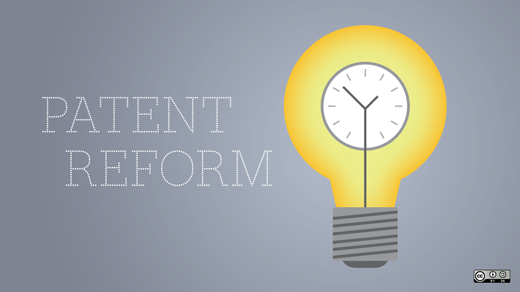During the August Congressional recess, the Government Accountability Office (GAO) released its long-awaited study on Non-Practicing Entities (NPEs), required under the America Invents Act (AIA).
The report paints a rather grim picture of the current patent system. It reinforces the call by key leaders in Congress for legislative reforms that address abusive patent litigation as well as action by the Federal Trade Commission (FTC), the courts, and the US PTO.
Among the important disturbing trends the report identified:
- Between 2007 and 2011, two-thirds of defendants in patent litigation were sued over software-related patents.
- Among the most important factors contributing to patent litigation abuse are the prevalence of unclear and overly broad patents.
- Lawsuits involving software-related patents accounted for 89% of the total increase in defendants from 2007-2011.
- By "2011 patents related to software made up more than half of all issued patents," meaning the problem and challenges we face today are going to get worse before they get better.
- NPEs brought approximately 20% of all the cases studied by GAO between 2007-2011.
- They sued four times more defendants in 2011 compared to 2007, and relative to operating companies, tend to sue many more defendants per suit than operating companies.
- In many cases brought by NPEs, the real identity of the party behind the lawsuit and who benefits financially is obscured intentionally.
- An estimated 39% of suits involving software-related patents were brought against non-technology companies, such as retailers, hotel chains, public transit agencies, and other everyday businesses, a dramatic increase in recent years.
- The potential for disproportionately large damage awards remains a key factor in litigation abuse – an issue that was left on the cutting room floor during consideration of AIA.
- There has been a fundamental shift from using patents to protect ideas to aggressive strategies for monetizing portfolios (regardless of the innovation embodied in the invention).
Some commentators, primarily from the traditional patent bar which has resisted any changes to current law, suggest that the report "begs the question of whether drafting new legislation is really needed."
But that view is misplaced and in a distinct minority. For those following the GAO work closely, it became clear that consideration of legislative alternatives was unlikely to be a focus of their work. Silence in the report does not equate to calls for non-action.
The GAO did outline steps for the US PTO to take, reflecting its greater comfort in making recommendations to an Executive Branch agency. The report also points to the role of the courts.
Evidence builds for legislative reforms
In this light, the GAO report is the latest evidence that there is not a silver bullet solution. As FTC Chairwoman Ramirez observed earlier this summer, there is a growing consensus that:
Flaws in the patent system are likely fueling much of the real costs associated with PAE activities.
...effective monetization of low quality patents imposes a de facto tax on productive economic activity with little or no offsetting benefit for consumers. High litigation costs add to the problem by allowing PAEs to coerce targets to pay license or settlement fees that are detached from the economic value of the patents at issue. In short, PAEs exploit underlying problems in the patent system to the detriment of innovation and consumers.
The GAO emphasizes the role of patent quality improvements in its report. But even there, the report is far from suggesting that this will solve the basic flaws.
At best, such incremental steps can only help in the future. And with the rising number of software-related patents the challenge will be enormous. Such efforts do little to address the large number of overbroad, unclear patents that exist today. Even the USPTO has acknowledged this with its "Software Qualty Partnership" efforts, which recognize the agency’s assessment that "software-related patents pose unique challenges from both an examination and an enforcement perspective."
Some who are opposed to legislative reforms have jumped on one sentence in the GAO’s conclusion that "the focus on the identity of the litigant—rather than the type of patent—may be misplaced."
This one line is hardly a recommendation of no action, especially since the GAO avoided commenting on legislative alternatives.
In fact, the current landscape of legislative reforms that are under serious consideration have moved beyond this debate. The key areas of focus of the major proposals are litigant agnostic—they seek to address the abusive practices generated by lack of clear pleadings; fixing the Post-Grant review estoppel; and expanding a carefully tailored program that takes the question of the validity of certain covered business methods out of the expensive court process into an administrative proceeding.
Other priority provisions are being crafted to address the specific ways that NPEs game the system without prejudice to a plaintiff litigant’s stature. These include addressing the asymmetric costs associated with suits brought by a NPE, whose current calculation to bring suit is today relatively risk free; reducing discovery abuses; and seeking to protect down stream users from being 'held up' by demand letters that force settlement rather than fighting back.
In my view, the GAO missed a critical point: that the 20% actually represents, as many studies have shown, some of the most egregious litigation abuses. As one observer noted publicly, "[t]he GAO largely punted on the mandate by Congress to determine what the impact of nonpracticing entities has been on the U.S. economy in recent years." Why did they miss this? It’s not entirely clear.
It is worth noting that the GAO acknowledges that a lot of NPE activity occurs outside of the courtroom. (This is a key point raised by FTC Chairwoman Ramirez and other Commissioners as the agency assesses its own roadmap for action.)
In short, it may be ‘only’ 20%, but it is the tip of the iceberg of abusive practices that have been well documented and studied that are unique to the NPE business model and which legislative reforms—and other actions—are necessary to mitigate.
As many others have pointed out, the GAO report provides ample additional evidence that the current litigation abuses are undermining confidence in the patent system and costing job-creating American businesses.
It’s critical we work together to support the on-going efforts by leaders in both the House and the Senate, supported by the White House, to find meaningful measures that turn the tide of abusive patent litigation. The GAO study is the latest evidence that such actions are needed.







5 Comments